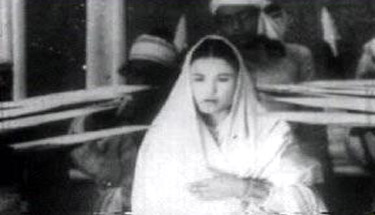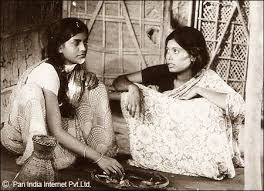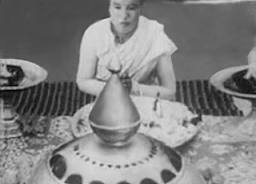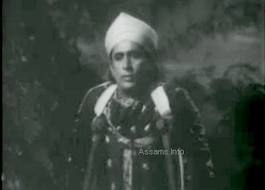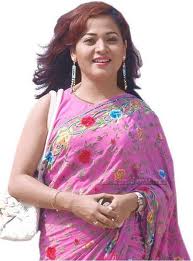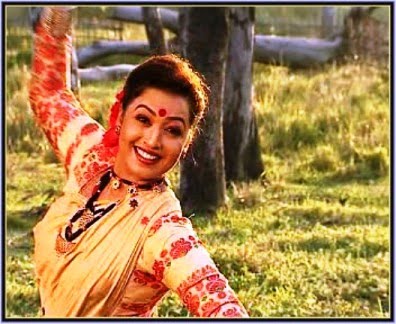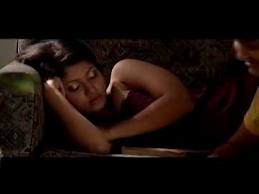Assamese cinema
This is a collection of articles archived for the excellence of their
content. You can update or correct this page, and/ or send photographs to the Facebook page, Indpaedia.com. All information used will be duly acknowledged. |
The authors of this page include
Rupraj Sarmah The Sunday Indian
Utpal Borpujari Outlook
(There are identical articles by Rupali Parda onRupali Parda, Rupkamal on itsmynortheast, Anon on assamonline and Tourism Assam
The article has been given greater depth with information contained in How Assamese film found its mojo Bobbeeta Sharma, scroll.in
History
The origin of Assamese Cinema can be traced back to the dreams and imagination of a revolutionary visionary Rupkonwar Jyotiprasad Agarwala, who was also a distinguished poet, playwright, composer and freedom fighter. He was instrumental in the production of the first Assamese Film “Joymati”, under the banner of Critrakala Movietone. Due to the lack of trained technicians, Jyotiprasad, while making his maiden film, had to shoulder the added responsibilities as the script writer, producer, director, choreographer, editor, set and costume designer, lyricist and music director. The film, completed with a budget of Rupees Sixty thousand and was released on March 10th, 1935. The picture failed miserably. It is unfortunate that like so many early Indian films , the negatives and complete prints of Joymati are missing.
Not withstanding the failure of his venture, Jyotiprasad made another film after a lapse of two years titled “Indramalati(1939)”. It was his second and last film. The eminent composer and singer of Assam Dr. Bhupen Hazarika, played a stellar role in the play. With the passing away of Jyotiprasad, the Assamese film scene witnessed a temporary lull for about a couple of years. But things changed with the onset of war, Taking advantage of this, the Late Rohini Kr. Baruah made a film on a relevant historical topic called “Manomati (1941)”. It was followed by films like Parvati Baruah's Rupahi (1946), Kamal Narayan choudhury's Badan Barphukan (1947), Phani Sharma's Sjiraj, Asit Sen's Biplabi, Prabin Phukan's Parghat Suresh Goswami's Runumi etc. Runumi (1952)
But the most remarkable film of the fifties was Piyali Phukan which went on to win a National award. In 1955, a new talent Nip Barua made his directorial debut with Smrit Paras. His subsequent films Mak Aaru Moram and Ranga Police bagged many state awards and the silver medal at the national level. Dr. Bhupen Hazarika also produced and directed his first film Era Batur Sur. Prabhat Mukherjee made a film on the universality of mother-hood, Puberan (1959).,which was shown in The Berlin Film Festival. The next memorable production was Lachit Borphukan by Sarbeswar Chakraborty. Dr. Bhupen Hazarika made his unforgettable musical lore Shakuntala (1961) which proved equally successful with critics and the press. It also won president's silver medal. Following this, a chain of films went into regular production and got released which included Nip Barua's Narakasur, Anil Choudhury's Matri Swarga, Brojen Barua's Itu Setu Bahuto and Mukta & Anwar Hussain's Tejmala.
By the middle of the sixties, film were produced in Assam on a regular basis. It should also be mentioned here that between 1935 ad to 1970 a total of 62 films were produced. Besides the film makers already referred to, many others engaged in film making during the period included Pravin Sharma, Saila Barua, Abdul Mazid, Amar Pathak, Indu Kalpa Hazarika, Diben Barua, Debkumar Basu, Amulya Manna, Gauri Barman, Atul Bardoloi, Sujit Singh, Nalin Duara and Prafulla Barua.
During the period of 1970-82 a total of 57 Assamese films were made. New directors started emerging on the horizon. Samarendra Narayan Deb's Aranya (1970), Kamal Choudhury's Bhaity (1972) the first colour film of Assam, Manoranjan Sur's Uttaran (1973), Deuti Barua's Bristi (1974) Pulok Gogoi Khoj (1974) Padam Barua's Ganga Chilanir Pakhi (1976) and Dr. Bhabendranath Saikia's Sandhya Rag (1977) and Atul Bordoloi's Kollol (1978) are films worth - mentioning.
The outstanding directors of contemporary Assamese Cinema are Jahnu Baruah (Aparoopa, Papori, Haladhia Choraye Baodhan Khai, Banani, Firingoti, Hkhagoroloi Bohu Door) ; Sanjeev Hazarika (Haladhar, Meemanxa); Bhabendaranatha Saikia (Anirbaan, Agnisnaan, Sarothi, Kolahol, Abartan, Itihaas, Kaal Sandhya) Dr. Santwana Bordoloi (Adajya) and Bidyut Chakraborty (Rag Birag). Their Films have won National & International Awards
Indian Film History :
As India was poised for a socio-political upheaval at the turn of the 20th century, a new form of entertainment arrived in India- the cinema. This art form which made a humble beginning went on to make a mighty bang and sophisticated multi-million-rupee movies of the present day are a far cry from the soundless short films that made a silent entry into the Indian hearts in its early phase. Be it as an art form, a social weapon or a political satire, the cinema has made a tremendous impact on the Indian society as few other forms of art have.
The first exposure to motion pictures which India received was in 1896, when Lumiere Brother's Cinematographe unveiled six soundless short films at Bomay's Watson Hotel. And the first exposing of celluloid in camera by an Indian (Harishchandra Bhatvadekar), and its subsequent screening took place in 1899.
During the first decade of 20th century, only silent short films were made in India. It was during the first half of the next decade that the first indegenous feature film Raja Harishchandra was made by D.G. Phalke (1913). By 1920, film production had grown into a regular industry bringing out silent films in various Indian languages.
Indian Cinema made a big leap forward with the arrival of Alam Ara, the first talkie feature film by Ardeshir Irani in march 1931. It was during the Thirties that attempts were made to produce talkie films in different languages. Regional culture and the craving to see and hear a film in ones own mother tongue caused a mushrooming of film industries in all major centres. The fore runners were Bengali, Tamil, Telegu followed by Marathi, Kannada, Malayalam, Gujrati, Oriya, Assamese and several languages in later years: every regional cinema came up with its own directors and artists; regional film also took to earth and realism, winning many awards and honours in India and abroad in the process.
The 1930s
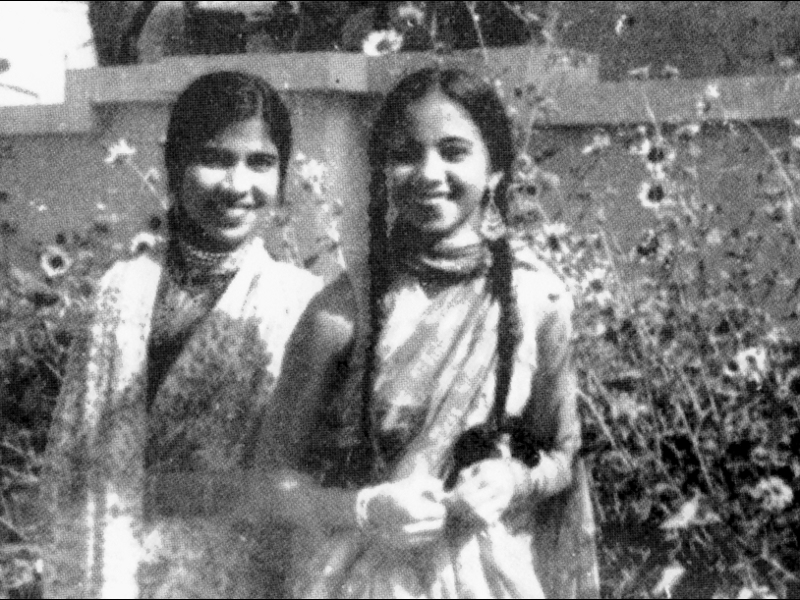
Number of films released: 2
The origin of Assamese Cinema can be traced back to the dreams and imagination of a revolutionary visionary Rupkonwar Jyotiprasad Agarwala, who was also a distinguished poet, playwright, composer and freedom fighter. He was instrumental in the production of the first Assamese Film Joymati in 1935, under the banner of Critrakala Movietone.
Due to the lack of trained technicians, Jyotiprasad, while making his maiden film, had to shoulder the added responsibilities as the script writer, producer, director, choreographer, editor, set and costume designer, lyricist and music director. The film, completed with a budget of 60,000 rupees was released on March 10, 1935.
The picture failed miserably.
It is unfortunate that like so many early Indian films , the negatives and complete prints of Joymati are missing. Some effort has been made privately by Altaf Mazid to restore and sub-title whatever is left of the prints.
Despite the significant financial loss from Joymati the second picture Indramalati was filmed between 1937 and 1938 finally released in 1939.
Remaining strong in the face of adversity, Agarwala made another film after a lapse of two years titled Indramalati. It was his second and last film.
The 1940s
Number of films produced: 5
The eminent composer and singer of Assam Bhupen Hazarika, played a stellar role in the play. With the passing away of Jyotiprasad, the Assamese film scene witnessed a temporary lull for about a couple of years.
But things changed with the onset of World War II, Taking advantage of this, Rohini Kr. Baruah made a film on a relevant historical topic called Manomati in 1941.
All Assamese films made in the 1940s
1941 Monumati dir: Rohini Kumar Baruah
1944 Rupahi dir: Parbati Prasad Baruah
1947 Badan Borphukon dir: Kamal Narayan Choudhury
1948 Siraj dir: Kamal Narayan Choudhury
1949 Parghat dir: Prabin Phukan
The 1950s
Number of films produced: 19
The most remarkable film of the fifties was Piyali Phukan which went on to win a National award. In 1955, a new talent Nip Barua made his directorial debut with Smrit Paras. His subsequent films Mak Aaru Moram and Ranga Police bagged many state awards and the silver medal at the national level. Bhupen Hazarika also produced and directed his first film Era Bator Sur. Prabhat Mukherjee made a film on the universality of mother-hood, Puberan (1959),which was shown in The Berlin Film Festival.
The mid-1950s saw the emergence of composer-singer Bhupen Hazarika as a filmmaker too, with his directorial debut Era Bator Sur (Tunes from the Deserted Path) showcasing the musical genius in him. He went on to make films like Pratidhwani, Lotighoti and Chikmik Bijuli, each different in genre and thus reflecting Hazarika’s versatility. The talent of the 1950s was Gyanada Kakati whose role in Puberun brought her critical recognition. She was first seen in Parghat (1949) and also acted in Ronga Police
Prominent films and their awards
1955: Piyoli Phukan (writer and director Phani Sarma/ Rupjyoti Production): Awarded a Certificate of Merit at the 3rd National Film Awards. It was the first Assamese or north-eastern film to get a national award. This was the landmark film that not only put Assamese cinema on the national map, it brought technical sophistication to Assamese cinema. The acting in the film was as good as in the rest of the country. It was the twelfth film ever made in Assamese.
1957: Mak aru Maram (Mother’s love) dir: Nip Barua/ Certificate of Merit at the National Film Awards,
1958: Ronga Police (Red Police) dir Nip Barua, the President’s Silver Medal: the first Assamese film to get such a high national prize;
1959: Puberun (The Eastern Sun) (language: Assamese) dir Prabhat Mukherjee (who had a respected position in the Bengali film-industry), the second Assamese film to get the President’s Silver Medal + selected for the Berlin International Film Festival. The first Assamese film to be selected for an international film festival.
All 1950s films in Assamese
1950 Biplobi Dir: Asit Sen Music: Shiv Bhattacharjee
1952 Runumi Dir: Suresh Chandra Goswami Music: Darpa Nath Sarma (See the independent page Runumi (1952))
1954 Sati Beula Dir: Sunil Ganguly Music: Bhupen Hazarika
1955 Nimila Onko Dir: Lakshyadhar Choudhury Music: Purushuttam Das
1955 Piyoli Phukon Dir: Phani Sarmah Music: Bhupen Hazarika
1956Sorapaat Dir: Anuwar Hussain Mukul Barua
1956Smritir Porosh Dir: Nip Barua Music: Brajen Baruah
1956Lakhimi Dir: Bhaben Das Music: Brajen Baruah
1956Era Bator Sur Dir: Bhupen Hazarika Music: Bhupen Hazarika
1957 Maak Aru Morom Dir: Nip Barua Music: Brajen Baruah
1957 Dhumuha Dir: Phani Sarmah Music: Bhupen Hazarika
1958Ronga Police Dir: Nip Barua Music: Nijam
1958 Notun Prithibi Dir: Anuwar Hussain Music: Mukul Barua Rajeswar Bordoloi
1958 Bhakta Prahlad Dir: Nip Barua Music: Brajen Barua
1959 Kecha xun Dir: Phani Sarmah Music: Bhupen Hazarika
1959 Chaknoiya Dir: Saiyo Barua Music: Mukul Barua
1959 Puberun Dir: Prabhat Mukharjee Music: Tarikuddin Ahmbed
1959 Puwaoti Nishar Sopun Dir: Phani Sarmah Music: Bhupen Hazarika
1959 Amar Ghor Dir: Nip Barua Music: Brajen Barua
All-India talent comes to Assam
The surest sign of the newfound respect that the whole nation had begun to view Assamese cinema with was that under Hazarika’s baton the film Era Bator Sur attracted the nation’s very top singers, including Lata Mangeshkar, as well as Hemant Kumar (who was big in the 1950s) and Sandhya Mukherjee, in addition to singing by Hazarika himself. The film’s starcast included Balraj Sahni, who was an A-lister in Hindi-Urdu art cinema and a well-paid character artiste in commercial cinema. Era Bator Sur was a commercial success.
Director Prabhat Mukherjee came over from Bengal's by-then internationally reputed film industry.
This influx of all-India talent continued into the 1960s.
Mohammad Rafi, Kishore Kumar, Manna Dey, Asha Bhosle, Talat Mahmood, Suman Kalyanpur and Usha Mangeshkar, all sang in Asamese films, and not only under Hazarika’s baton. Four Hazarika films in the 1960s used singers of all-India fame, but so did, say, Bhaity.
The 1960s
The next notable film production was Lachit Borphukan by Sarbeswar Chakraborty. Bhupen Hazarika made his unforgettable musical Shakuntala in 1961 which proved equally successful with critics and the press winning the president's silver medal. Following this, a chain of films went into regular production and got released which included Nip Barua's Narakasur, Anil Choudhury's Matri Swarga, Brojen Barua's Itu Situ Bahuto and Mukta & Anwar Hussain's Tejimala.
By the middle of the sixties, film began to be produced in Assam on a regular basis. However, between 1935 and 1970 a total of 62 films were produced. Besides the film makers already referred to, many others engaged in film making during the period included Pravin Sharma, Saila Barua, Abdul Mazid, Amar Pathak, Indukal Pattazarika, Diben Barua, Debkumar Basu, Amulya Manna, Gauri Barman, Atul Bardoloi, Sujit Singh, Nalin Duara and Prafulla Barua.
Prominent films
1964 Pratiddhani President's Silver Medal for Best Feature Film in Assamese
1969 Doctor Bezbaruah National Award for Best Feature Film in Assamese
Shakuntala had some sequences in colour. While prints of the film survive, they are not publicly available. Indpaedia continues to seek them out.
Complete list of 1960s Assamese films
1961 Shakuntala Dir: Bhupen Hazarika Music: Bhupen Hazarika
1961 Lachit Borphukon Dir: Lakhyadhar Choudhury, Prabin Phukon Music: Brajen Barua
1962 Narakasur Dir: Nip Barua Music: Brajen Barua
1963 Itu Situ Bohutu Dir: Brajen Barua Music: Brajen Barua
1963 Matir Swargo Dir: Anil Choudhury Music: Jiten Dev
1963 Tezimola Dir: Anuwar Hussain Music: Rajeswar Bordoloi
1963 Maniram Dewan Dir: Sarbeswar Chakrabarty Music: Bhupen Hazarika
1964 Pratiddhani[3] Dir: Bhupen Hazarika Music: Bhupen Hazarika
1966 Lotighoti Dir: Bhupen Hazarika Music: Bhupen Hazarika
1968 Morom Trishna Dir: Abdul Mazid Music: Bibekananda Bhattacharjee
1968 Songram Dir: Amar Pathak Music: Asit Ganguly
1969 Chikmik Bijuli Dir: Bhupen Hazarika Music: Bhupen Hazarika
1969 Doctor Bezbaruah Dir: Brajen Barua Music: Ramen Barua
The 1970s
During the period of 1970-82 a total of 57 Assamese films were made. New directors started emerging on the horizon. Samarendra Narayan Deb's Aranya (1970), Kamal Choudhury's Bhaity (1972) the first colour film of Assam, Manoranjan Sur's Uttaran (1973), Deuti Barua's Bristi (1974) Pulok Gogoi's Khoj (1974) Padum Barua's Ganga Chilanir Pakhi (1976) and Dr. Bhabendranath Saikia's Sandhya Rag (1977) and Atul Bordoloi's Kollol (1978) are films worth - mentioning.
It was in 1976 that the Northeast got its first film since Joymoti that followed a realistic style of storytelling. The film was Ganga Chilanir Pakhi, directed by Padum Barua. Based on a novel by Lakshmi Nandan Bora, the film showcased Barua’s remarkable grasp of the medium, presenting a realistic picture of rural Assam. Unfortunately, it failed at the box office. In 1977, Assamese cinema really caught the attention of the outside world through Sandhyarag of Dr Bhabendra Nath Saikia, a physics professor, novelist and playwright who went on to make seven more films, including Agnisnaan, a powerful women’s rights story fixed in a feudal setting.
The 1980s
Notable directors of contemporary Assamese Cinema are Jahnu Baruah (who directed Aparoopa, Papori, Haladhia Choraye Baodhan Khai, Banani, Firingoti and Hkhagoroloi Bohu Door); Sanjeev Hazarika (Haladhar, Meemanxa) and Bhabendaranath Saikia who directed Anirbaan, Agnisnaan, Sarothi, Kolahol, Abartan, Itihaas and Kaal Sandhya). Other directors include Santwana Bordoloi who directed Adajya and Bidyut Chakraborty who made Rag Birag, both of which have won National & International Awards. Banani Banani is a village in Mali, populated by the Dogon people. ... Itihasa (Sanskrit: thus verily happened) refers collectively to the epic Hindu scriptures, detailing the actions of divine incarnations on earth while interspersing them with often large sections of philosophical and ethical discourse. ... Adajya is a 1996 Assamese language film directed by Santwana Bardoloi based on a novel by Indira Goswami. ...
It was Jahnu Barua, who debuted in 1982 with the gentle love story Aparupa, starring Suhasini Mulay, who took Assamese cinema to great heights through Halodhiya... and Hkhagoroloi Bohu Door (It’s a Long Way to the Sea).
It was Jahnu Barua, who debuted in 1982 with the gentle love story Aparupa, starring Suhasini Mulay, who took Assamese cinema to great heights through Halodhiya... and Hkhagoroloi Bohu Door (It’s a Long Way to the Sea).
The 2010s
2011
Commercial success of Assamese films released in 2011:
Name of The Film Director Budget Income
Raamdhenu Munin Baruah 1 Crores 50 Lakhs(approx)
Jaanmoni-The Movie Rajesh Bhuyan 25 Lakhs 30 lakhs(app)
Jetuka Pator Dore Jadumoni Dutta 30 Lakhs 3 lakhs(app)
Pole Pole Ure Mon Timothy Das Hanse 1 Crores 9 lakhs(app)
A Weekend Diganta Mazumdar 22 Lakhs 10 lakhs(app)
Jetuka Pator Dore was selected in 12th Dhaka (Bangladesh) International Film Festival held in 2012 in the "Cinema of the World" section.
2012
Most popular SONGs of the year 2012
1. Bilore Parote Amar Ai Gaon Khan (Bakor Putek)
2. Asilu Kotenu Lukai... Tumiyei je Taajmahal (Rowd)
3. Pokhi Pokhi Mon Mur (Rowd)
4. Toofani Hoi Aha (Rowd)
5. Surujmukhi (Rowd)
6. Kinu Jadu Aji Bukur Majat (Rowd)
2013
60th National Film Awards
1. Best Feature Film in Assamese: Baandhon (Jahnu Baruah)
2. Best Feature Film in Mising: Ko:Yad (Manju Borah)
3. Best Cinematography: Ko:Yad (Sudheer Palsane)
4. Special Jury Award (Feature Film): Bishnu Kharghoria (Baandhon)
5. Best Non-Feature Film Narration / Voice Over: Moni Bordoloi (Suranjana Deepali)
Prag Cine Awards 2013
The Awardees of Prag Cine Award 2013:
1. Life Time Achievement: Biju Phukan
2. Best Film: Bandhon
3. Best Director: Bidyut Chakaraborty (Dwaar)
4. Best Popular Film : Rishang (Producer- Pallavi Barua, Director- Manas Barua)
5. Best Film other than Assamese: The Essence of Life
6. Best Actor (Female): Barasha Rani Bishaya (Me & My Sister)
7. Best Actor ( Male): Kopil Bora (Dwaar)
8. Best Supporting Actor (Female): Purnima Saikia (Borolar Ghar)
9. Best Supporting Actor (Male): Lakshmi Borthakur (Borolar Ghar)
10. Best Playback Singer ( Female): Rupjyoti Devi (Rowd)
11. Best Playback Singer ( Male): Raj Jyoti Konwar (Rishang & Aakash Suboloi Mon)
12. Best Lyrics: Diganta Bharati (Me & My Sister)
13. Best Music: Sher Chowdhury (Dwaar)
14. Best Screenplay: Jahnu Barua (Bandhon)
15. Best Cinematography: Suman Duwara (Bandhon & Dwaar)
16. Best Editing: Ramen Bora & Jugal Das (Dwaar)
17. Best Sound Design: Dipak Dutta & Bijay Nath (Dwaar)
18. Best Art Direction: Phatik Barua (Bandhon)
19. Best Choreography: Deepak Dey (Rishang)
20. Best Costume Design: Lukumoni Gogoi (Borolar Ghar)
21. Best Makeup: Achitav Barua (Bandhon)
22. Best Critic : Arun Lochan Das
23. Jury’s Special Mention:
a) Adhyay
b) Aakash Suboloi Mon
Pulok Gogoi
Assamese Film and Theatre wrote: Veteran cinema director and renowned painter artist, Pulok Gogoi is known for his artistry and mature craftsmanship. Gogoi has straddled both the world – commercial and art, leaving his own distinctive signature. Much of his early works were experimental and produced on miniscule budgets. He has switched genrestoo, with films as diverse as the offbeat ’Khoj’ (1975) and comic–satiric ’Shrimati Mahimamayee’ (1979), which have achieved a cult status among both film fans and critics. Pulok Gogoi’s painterly eye comes in good measure in the aesthetics of his movie compositions. Most recently, he completed directing a new film titled 'Momtaaj' based on a short story by distinguished literary doyen Sayed Abdul Malik . The film was made under the banner of Sai Films.
The film is a tale of desperate love and heartbreak between star–crossed lovers Momtaaj and Bedana: Gogoi completed all the works in Guwahati itself for the first time in his movie career. Literary doyen, Sayed Abdul Malik’s works have been a great source of inspiration for Gogoi. In 1993, Pulok Gogoi made the film ’Railor Alir Dubori Bon’ from a short story by Sayed Abdul Malik. It went on to win the Best Film in the regional category at the National Film Awards. ’Momtaaj’ is Pulok Gogoi’s second film based on a short story by Malik after ’Railor Alir Dubori Bon’. He has also made several other serials and telefilms based on Malik’s short stories. ’Momtaaj’ with a length of two hours, features five songs in all. Three of the songs are written by eminent lyricist Narul Haque. Two other songs are written by Gautam Sarma and Palash Gogoi. The songs are rendered by Albela Khanom, Rupam Bhuyan, Rohit Sonar and Aman Ahmed. Music has always been an important ingredient of Pulok Gogoi’s movies. Infact, some of the most everlasting hits in #Assamesefilm are from his movies.
Its heartening to see a veteran director putting in so much hard work to his labor of love despite being grappled with health worries for years now. There’s an attempt being made here to try something different. The cast of artistes in ’Momtaaj’ are Bhargav Das, Ananya Parashar, Abdul Mazid, Jayanta Das, Hiranya Deka, Upakul Bordoloi, Ishaan Hazarika, Mani Bordoloi, Munna Ahmed, Monali Bordoloi, Rehana Ahmed, etc. Cinematography by Pradip Daimary. Editing by Diganta Khaund.
In October DURJON was released on 33 screens all over Assam and got the biggest opening across Assam
Events of 2013
From Assamese Film and Theatre:
Singer Papon (the voice behind Madras Cafe's Maula Sun Le Re, Barfi's Kyon and Dum Maaro Dum's Jiyein Kyun), an established folk singer, made his acting debut with Assamese film Rodor Sithi, directed by acclaimed theatre artiste Baharul Islam.
Infected, a short film directed by Fowzia Fathima was screened at the 10th Adda Short film festival .Adil Hussain and Shamaun Ahmed acted in the film.
Bobby Sarma Baruah’s debut feature film Adomya was selected for screening at the week–long 12th Third Eye Asian Film Festival, January 2014.
2014
The new year began with Jahnu Barua's new AssameseFilm "AJEYO". Cast: Rupam Chetia, Pratibha Choudhury, Jupitora Bhuyan, Kapil Bora, Bishnu Kharghoria, Munmi Kalita, Sourav Hazarika, Rimpee Das
Assamese film "SHINYOR" was the next to be released.
Assamesse Classic Movies
With additional inputs
By Mofid Tourism Assam
and Utpal Borpujari Outlook
Joymoti
The first assamese movie- Joymoti, directed by Jyoti Prasad Agarwalla was released in the year 1935. Joymoti was The first radical film of India
In the history of Indian cinema are a few filmmakers who, by virtue of their creative ability, intense labour and extraordinary perseverance, have come to be considered genius. D G Phalke, V Shantaram, Pramathes Barua, Himansu Roy, Ritwik Ghatak, Satyajit Ray are some such figures. Traveling through the little roads of Assam, we find another member of that pantheon: Jyotiprasad Agarwalla (1903-51), one of the greatest cultural figures to have been produced by the state. He made only two films, far less than other filmmakers, yet with his first film alone he could be distinguished as a radical auteur of all India. Nevertheless, he is little known.
Joymoti, released in 1935, added a new chapter in the chronicles of Indian cinema, primarily in the discourse of realism. Further, Jyotiprasad was the only political filmmaker of pre-independent India, though there were many in post-independent India, starting with Ritwik Ghatak. Above all else, Joymoti is a nationalist film in its attempts to create a cultural world using the elements of Assamese society. It is the only work of its kind of that period.
Assam’s freedom fighter-poet-playwright-lyricist-litterateur-and-composer Jyotiprasad Agarwalla, learnt the basics of filmmaking in Berlin’s UFA Studios under Franz Ozten and Himanshu Rai. From a family that had its roots in faraway Rajasthan but had adapted the Assamese culture several generations before him, Jyotiprasad chose the nationalistic tale of Joymoti, a 16th century princess of Assam’s Ahom dynasty who was tortured to death for not revealing the whereabouts of her husband Gadapani, the rightful heir to the throne. It was probably India’s first go at realistic filmmaking, and thanks mainly to lack of venues to screen his film in Assam, the film was an unmitigated financial disaster. Jyotiprasad, in the absence of local talent, had hired Lahore’s Bhopal Chandra Mehta as his cinematographer, and had to carry the responsibilities of being the scriptwriter, producer, director, choreographer, editor, set designer, lyricist and music director of Joymoti.
Jyotiprasad’s film was based on the play Joymoti Kunwari by Sahityarathi Lakshminath Bezbaruah, one of Assam’s all-time literary giants, thereby starting a tradition of close links between cinema and literature, something that continues till date. Joymoti was also the maker’s tribute to Gandhiji’s passive resistance movement—a freedom fighter, he was an ardent follower of the Father of the nation. It also had a strong feminist viewpoint, unlike the male-dominated films being made in other parts of the country at that time.
Rupahi
The fourth assamese movie Rupahi, produced & directed by Parbati Prashad Baruah was released in 1946. Screenplay, dialogue lyrics and even the music of the movie was composed by Parbati Prasad Baruah himself.
Siraj
Siraj is another remarkable Assamese Movie- directed by Phani Sarmah. Siraj is the sixth assamese movie released in 1948. The film speaks about the unity among the people of Hindu and Muslim community. Bishnu Rabha and Phani Sarmah, inspired by the story named ‘Siraj’ written by Lakshidhar Sarmah prepared the screenplay and dialogue of the movie. The outdoor shots were taken around Tezpur, the indoors being shot in Kali Film studio, Kolkata. The lead role Siraj was played by Phani Sarmah himself. Music was composed by Bishnu Rabha. Bhupen Hazarika and Shiva Bhattacharyya assisted him.
Era Bator Sur
Era Bator Sur is the first film of Dr. Bhupen Hazarika. The film was released in 1956. Dr. Bhupen Hazarika was then an active member of Indian people’s. Theater Association and in the fifties almost all the workers of I. P. T. A. were influenced by the sorrow and happiness, struggle and hope of the common mass and made themselves associated with creative works related to folk music and culture of the common assamese people. Era Bator Sur was also a result of one such effort. The story and the music of Era Bator Sur reflects the emotional rising of the people of that era. The theme of this movie is based on characters belonging to tea labourers society of Assam. The exploitations carried out by one class of the society also finds importance in the movie. Dr. Bhupen Hazarika is also the music director of the movie. The cast of the movie includes Phani Sarmah, Bishnu Rabha, Balraj Sahni along with Bijoy Shankar, Iva Asau, Tassaduk Yusuf etc.
Puberun
The first assamese film screened in an international Film Festival is Puberun. Directed by Prabhat Mukherjee of Kolkatta and released in 1959 the film was screened in ‘Berlin Film Festival’, 1960 and bought laurels to the state of Assam. Heroine of the movie Gyanada Kakoti was also present during the screening of the film in Berlil.
The story is based on mother-child relationship and the truth that every child of this world is equal. Another remarkable feature of this film is that "Margaret Anderson" of London Dramatic school acted in this film. In the history of Assamese Cinema this was for the first time that an actress from England, acted in an assamese film.
The role of the mother was played boldly by Gyanada Kakoti and against her was Tassaduck Yusuf . Music was by Tarikuddin Ahmed . Puberun even won the Presidents Award.
Saknoiya
Saknoiya is the only film directed by Soilo Baruah. The film got released in the month of November, 1959. Story, screenplay and dialogue was written by Durgeswar Barthakur. The indoor shots of this movie took place in Indrapuri Studio, Kolkatta. The editing of this film was also done in Kolkatta.
The story revolves round the emotions of two brothers, one a taxi driver and another a high official in a government office who marries a lady who would not agree to reside together with a taxi driver. The actors include Gyanada Kakoti, Bina Baruah, Tulsi Das, Sorbeswar Chakravarty, Bina Das, Soilo Baruah, Anil Das, Durgeswar Barthakur, Saityen Choudhury etc. Mukul Baruah was the music director.
Doctor Bezbaruah
Brojen Baruah’s Doctor Bejbaruah released in the year 1960, marked the beginning of success of so called commercial movies in Assamese Film industy. Following the footsteps of Doctor Bejbaruah directors / produces got encouragement to make commercially hit movies in later days of Assamese Cinema.
Though this film laid the base of the commercial value of a movie, yet it put a question mark on making movies based on the simple life of Assamese village folk.
Dr. Bezbaruah was the first Assamese thriller movie and also for the first time the outdoor and indoor shooting entirely took place in various locations of Assam.
Gonga Silonir Pakhi
গঙা চিলনীৰ পাখি (1976)
Release Date: 12 March, 1976
Producer: Rupjyoti Films
Director: Podum Barua
Cinematography: Indukalpa Hazarika
Music: Podum Barua
Editing: Samaresh Bose
Starring: Bina Baruwati, Basanta Saikia, Basanta Duwerah, Asima Saikia, Bina Das Manna, Bhola Kakati
Guest Apprearance: Aideu Handique, Mohini Rajkumari
Gonga Silonir Pakhi, directed and produced by Padum Baruah and released in 1976, is one of remarkable assamese movies released till date. The music was also composed by Padum Baruah himself. Renown novelist Dr. Lakhminandan Bora wrote the main story, screenplay was by Padum Baruah. The story is based on the simple life of the villagers of Assam.
Some landmark films
BHAITI
(1972)
First Assamese Colour Film
directed by Kamal Narayan Choudhury
CHAMELI MEMSAAB
(1975)
Film Direction- Abdul Majid
Music Direction- Dr. Bhupen Hazarika
"Best National Regional Movie" Award...t
Tothapio Nadi
(1989)
dir: Hemanta Das
Writer: Hemanta Barman (based on his story Sankalpa)
The film depicts the difficult lives of the boatmen of the river Brahmaputra after the construction of the first bridge over it.
Cinematographer: Indukalpa Hazarika
Music: Tarun Das
Tpl: 70-minutes
Awards won: EIMPA awards for best photography and best supporting actress.
Jetuka Patar Dare
(2010)
English Title: Enchanting, Challenging……………The Life
Director: Jadumoni Dutta
Story: Syed Abdul Malik
Music Director: Polash Gogoi
Award: Best Assamese Film (58 National Award)
Cast: Aimee Barua, Raag Ainitam, Bishnu Khargharia, Biki, Kapil Borah, Rajkumar, Arun Hazarika, Pabitra Barua, Jayanta Bhagabati etc.
The film is set to the backdrop of an interior village of 1970’s, which has never seen progress and prosperity. Poor farmers and fishermen of the village are always victim of unabated exploitation by contractor Jamuna Hazarika, a wealthy villager. Radha, an orphan grew up in the family of her...
Assamese Cinema: Glorious past, crisis-ridden present
Rupraj Sarmah, June 23, 2012
Celebrating 100 years of Indian Cinema
Assamese Cinema: Glorious past, crisis-ridden present
The foundation of the film industry in Assam was laid by the pioneering spirit of Jyotiprasad Agarwala. A poet, playwright, composer and freedom fighter, he learnt the art of filmmaking in Germany in the early 1930s.
Agarwala made Assam’s first film, Joymoti, a talkie, in 1935. It was a herculean task because the region had no technicians and equipment. He was a veritable one-man unit, serving as producer, scriptwriter, editor, set and costume designer, lyricist and music director.
The film’s audiographer made mistakes and the sound recorded on location wasn’t up to scratch. So Agarwala had to step in and dubbed the voices of all the characters. Joymoti cost Rs 60,000. But the film did not get the expected response from the public.
There were no cinema halls in Assam back then. Agarwala travelled to different localities with a projector to screen Joymoti. Large parts of the negative of the film are missing, but filmmaker Altaf Mazid has made efforts to salvage whatever is left of the original print.
Agarwala’s second and last film, Indramaloti (shot in 1937-1938 and released in 1939) fared much better and fetched him some profits. Bhupen Hazarika, who went on to become Assam’s best-known composer, lyricist and singer, played a stellar role in the film.
Agarwala passed away aged 43. It took Assamese two years to recover from the irreparable loss. In 1941, Rohini Kumar Boruah made a film called Manomati. It was followed by films like Parvati Prasad Boruwa’s Rupohi, Kamal Narayan Choudhury’s Badan Barphukan, Phani Sharma’s Siraj, Asit Sen’s Biplobi, Prabin Phukan’s Paarghat and Suresh Goswami’s ‘Runumi’, all made in the 1940s.
The 1950s saw several important Assamese films being made – Phani Sharma’s Piyali Phukon, Nip Baruah’s ‘Smritir Parash, Maak aru Morom and Ronga Police, Bhupen Hazarika’s Era Bator Sur, and Prabhat Mukherjee’s Puberun. Hazarika composed the music for Piyali Phukon. Another important development of that decade was emergence of young film director Nip Boruah, who directed many popular films later.
Puberun was shown in the Berlin Film Festival. On the other hand, Piyali Phukon and Maak aru Morom earned a national-level certificate of merit in 1955 and 1957 respectively.
The period between 1959 and 1969 is generally regarded as the golden age of Assamese cinema. In all 25 films were made during the era and nine of them won National Awards.
In the 1960s, Sarbeswar Chakraborty’s Lachit Barphukan, Bhupen Hazarika’s musical Sakuntala and Chik Mik Bijulee, Nip Barua’s Narakasur, Anil Choudhury’s Matri Swarga, Brajen Baruah’s Itu Situ Bahuto and Mukuta and Anwar Hossain’s Tejimola were released.
Hazarika won the National Award for best music for his work in Abdul Mazid’s Chameli Memsaab, released in 1975. Mazid earned acclaim for subsequent films like Bono Hongso (1977) and Uttarkaal (1990).
From 197o to 1982, 57 Assamese films were made. Several promising directors emerged during this period. Samarendra Narayan Deb’s Aranya (1970), Kamal Choudhury’s ‘Bhaitee’ (the first Assamese film in colour made in 1972), Manoranjan Sur’s Parinam (1974), Deuti Baruah’s Bristi (1974), Pulok Gogoi’s Khoj (1974), Padum Barua’s Gonga Silonir Pakhi (1976), Bhabendra Nath Saikia’s Sandhya Raag (1977) and Atul Bordoloi’s ‘Kallol’ (1978) were the notable films that gave Assamese cinema a new prestige.
Bhabendranath Saikia triggered a new wave of Assamese films with a socially conscious brand of cinema. An acclaimed writer, he directed a string of outstanding films in the 1970s and 1980s – Sandhya Raag, Anirban, Agnisnan, Sarothi, Kolahal, Abartan, Itihaas and Kaal Sandhya.
Another Assamese cinema luminary, Jahnu Barua, emerged in the 1980s. With films like Aparoopa, Papori, Halodhia Choraye Baodhan Khay, Bonani, Firingoti and Khagoroloi Bohu Door, he established himself as a globally feted director. Halodhiya Choraye Baodhan Khay won the Best Film National Award in 1987.
Other prominent Assamese filmmakers who subsequently made a mark are Goutam Bora, Sanjeev Hazarika, Bidyut Chakraborty. Santwana Bordoloi, Manju Borah, Jadumoni Dutta and Sanjib Sabhapandit.
Goutam Bora’s Wosobipo, a film in the Karbi language, and Sons of Abotani (a documentary) earned much acclaim. Sanjeev Hazarika’s Holodhor, Santwana Bordoloi’s Adajya, Bidyut Chakraborty’s Rag-Birag, Manju Borah’s Baibhab and Laaj, and Jadumoni Dutta’s Jetuka Pator Dore (2011) are particularly worth mention.
On the other hand, a crop of commercial films enjoyed a brief run in the 1990s. Joubane Amoni Kore and Hiya Diya Niya were huge hits. The last of such box office success stories was that of Ramdhenu. In the past decades or so, Assamese cinema has struggled to woo the audience back to the theatres.
All through its history, Assamese cinema has experienced sterile phases. According to film critic and cultural activist Nayan Prasad, innovation is the only way forward. He points out that with the availability of new digital technology, shooting a film is today cheaper than ever before. “We have to adopt new technologies, manage financial resources better and make films with controlled budgets in order to be viable,” says Prasad.
On the other hand, National award-winning filmmaker Sanjeev Hazarika believes the current crisis in Assamese cinema is actually a part of the greater turmoil that “our society faces as a whole”. He says: “A positive social change is very important for progress in any cultural sphere.”
________________________________________ ________________________________________
The Firsts of Assamese cinema
Sources: Rupali Parda and others
Sl. No Category Description
1 First film maker of Assamese film Jyoti Prasad Agarwal
2 First Assamese film director Pramathesh Baruah, He Directed the Bengali film “Devadash” in 1934.
3 First director of an Assamese film Jyoti Prasad Agarwala; he directed “Joymati”. The film was released at Raonak Cinema (now Jyoti Cinema), Kolkata on 10th March 1935 and in the same year on 20th March at Kumar Bhaskar Natya Mandir, Guwahati.
4 First dubbed film in India Joymati (1935)
5 First Assamese actor to act in a Bengali Movie Pramathesh Baruah. He acted in “Taki Kini Gulam” in 1930.
6 First Full length comedy movie in Assamese film "Ito Sito Bahuto", Director was Brajen Barua.The film was released in 1963.
7 First film with actor from outside of Assam "Era Batar Sur", released in 1956.Balraj Sahani acted in this film as a guest appearance. Dr. Bhupen Hazarika was the director.
8 First Assamese partly coloured movie Shakuntala, released in 1961.The film was directed by Dr. Bhupen Hazarika.
9 First Colour movie Bhaity (1972), Director was Kamalnarayan Choudhury.
10 First Assamese film dubbed from Hindi Bhagya (1968).
11 First Assamese thriller "Dr. Bezbaruah" (1969), Directed by Brajen Baruah.
12 First Assamese film where a non Assamese singer sang a full song "Era Batar Sur"; here legendary singer of Indian Music Lata Mangeskar sang a song under the music direction of Dr. Bhupen Hazarika.
13 First Assamese film to be screened in a foreign land 'Puberun' (1959). It was screened in Berlin. Director was Prabhat Mukherjee.
14 First Long playing record of an Assamese Film "Chik-mik Bijuli" (1969), directed by Dr. Bhupen Hazarika.
15 First Assamese film to receive a national award "Piyali Phukan", this film received the Repute Certificate of Merit. Directed by Phani Sharma.
16 First adult movie "Marichika" (1972); directed by Amulya Manna.
17 First adult movie which was released "Hridayar Prayojan" (1972), directed by Gauri Barman.
18 First movie broadcast in Doordarshan 'Bristi' (1974), directed by Deuti Baruah.
19 First movie screened in Indian panorama 'Sandhyarag' (1977), directed by Dr. Bhabendranath Saikia.
20 First Eastman colour movie 'Ajali Nabou' (1980), directed by Nip Baruah.
21 First lady director Suprabha Devi, she directed 'Nayanmani' in 1983.
22 First Assamese cinema scope movie 'Jeevan Surabhi' (1984), directed by Naresh Kumar.
23 First movie to get best screen play award in national level 'Agnisnan' (1985), Directed by Dr. Bhabendranath Saikia.
24 First film to receive Swarna Kamal award 'Haladhiya Charaye Baodhan Khaay' (1987), directed by Jahnu Baruah.
25 First children movie Abuj Bedana (1993), directed by Gunasindhu Hazarika.
26 First film which was screened as an Inaugural movie of the Indian panorama Rag Birag (1996), directed by Bidyut Chakrabarty.
________________________________________ ________________________________________
National & International Awards (Assamese Films)
Year Name of the Film List of Awards
1955 Piyoli Phukan President's Certificate of Merit
1957 Maak Aru Maram President's Certificate of Merit
1958 Rangaa Police President's Silver Award
1959 Puberun President's Silver Award
1961 Shakuntala President's Silver Award
1963 Tejimola President's Certificate of Merit
1963 Maniram Dewan President's Silver Award
1964 Pratiddhani President's Silver Award
1966 Latighati President's Silver Award
1969 Dr.Bezbaruah National award- Best Regional Film
1971 Aranya National award- Best Regional Film
1972 Upaja Sonar Maati National award- Best Regional Film
1973 Mamata National award- Best Regional Film
1975 Chameli Memsaab National award- Best Regional Film
1976 Putala Ghar National award- Best Regional Film
1977 Sandhyaraag National award- Best Regional Film
1978 Kallol National award- Best Regional Film
1981 Anirban National award- Best Regional Film
1982 Aparupa National award- Best Regional Film
1983 Alokar Aahban National award- Best Regional Film
1984 Son Maina National award- Best Regional Film
1985 Agnisnan National award- Best Regional Film
1986 Baan National award- Best Regional Film
1986 Aalayaran (Bodo) National award- Best Regional Film
1987 Pratham Raagini National award- Best Regional Film
1987 Haaladhiya Charaye Bawdhan Khaai National award- Best Film, Second Best Film ( Locarno Interntl. Film Festival )
1989 Kolahal National award- Best Regional Film
1990 Zooj National award- Best Regional Film
1991 Phiringati National award- Second Best Film
1992 Saarathi National award- Best Regional Film
1993 Railor Alir Dubori Ban National award- Best Regional Film
1994 Aabartan National award- Best Regional Film
1995 Saagaraloi Bahu Door National award- Best Regional Film, GETZ Prize( 31st Chicago Interntnl. Film Festival ), Pri Do Public Award (Best Film:Nantes Film festival,France)
1996 Itihaas National award- Best Regional Film
1997 Adajjya National award- Best Regional Film & Jury's special award
1998 Kushal National award- Best Regional Film
1999 Pakhi National award- Best Regional Film
2002 Kanikar Ramdhenu National award- Best Regional Film
2003 Akashitarar Kathare National award- Best Regional Film
2003 Tora National award- Best Children Film
2004 Dinabandhu National award- Best Regional Film
________________________________________ ________________________________________
National & International Awards(Director, Music director...)
________________________________________ ________________________________________
Year Name of Artist Category List of Awards
1975 Dr. Bhupen Hazarika Best Music Director ("Chameli Memsaab") National Award
1985 Dr. Bhabendra Nath Saikia Best Screenplay ("Agnisnan") National Award
1988 Indra Bania Best Actor ("Haaladhiya Charaye Bowdhan Khaai") Locarno Internatnl. Film Festival
1990 Gautam Bora Director's Best Debut Film ("Woshbipo") National Award- Indira Gandhi Award
1991 Moloya Goswami Best Actress ("Firingati") National Award
1993 Sanjeev Hazarika Director's Best Debut Film ("Haladhar") National Award- Indira Gandhi Award
1995 Jahnu Barua Best Director ("Sagaraloi Bahu Door") National Award
1995 Bishnu Khargharia Best Actor ("Sagaraloi Bahu Door" ) Singapore Internatnl. Film Festival
1996 Bidyut Chakraborty Director's Best Debut Film ("Raag Biraag") National Award- Indira Gandhi Award
1996 Srikar Prasad Best Editor ("Raag Biraag") National Award
2003 Tarali Sharma Best Playback Singer - female ("Akashitarar Kathare") National Award
Assamese Films/ Anon
Assamese films are an integral part of Indian film industry. It originated from the 1930s. This film industry more or less grew simultaneously with the Bengali films.
The first Assamese film to release was Joymoti by Jyoti Prasad Agarwala in 1935. Jyoti Prasad drew on historical and literary sources to depict the tragic patriotism of a princess produced his first film. Along with this he also portrayed the parallels with the situation of disorder and disharmony unleashed by the British rule on the people of Assam for aligning themselves with the National Movement. The film starred Phanu Barua, Asaideo Handige, Mohini Rajkumari, Phani Sarma, Sneha Chandra Barua, and Shamshul Haque.
However, the Assamese audience did not appreciate Agarwala`s film. Although not a commercial success, it is notable that at a time when the Bombay cinema was producing mythological films, Joymoti was about an historical event.
With the movies of Bhabendra Nath Saikia and Jahnu Barua Assamese films got recognition from the entire nation. Biplabi was a film Directed by Asit Sen in 1948. This film starred Anupama Bhattachrya, Chandra Phukan, Rani Nath and Jagat Bezbaruah. The film dealt with the theme of nationalism and sacrifice. The technical quality of the film set it apart from other films of the genre.
In the 1930s and 1940s the Assamese films that were made did have a lot of flaws. But in the 1950s the scenario altered as far as serious cinema was concerned. Piyali Phukan won the National award. The film was directed by Phani Sharma and the plot revolved around the life of a freedom fighter, Piyali Phukan. It was during these days that the Assamese director Nip Barua made his debut. His first film was Smrit Paras. He later made Assamese movies like Mak Aaru Moram and Ranga Police. These films were felicitated by the State Award of Assam.
In the year 1955 Era Bator Sur was directed by Bhupen Hazarika. This film starred Phani Sarma, Bishnu Rabha, Bijoy Shankar, Anil Das, and Chhaya Devi. The Assam tea gardens are the setting for this love story: a researcher and a flautist fall in love with the same woman. The researcher steps aside because he believes the flautist`s art to be indispensable. The film focuses on the tea gardens and the folk music of the workers.
By the middle of the 1960s Assamese films were made on a regular basis. The film industry grew with time. The Assamese movies went onto win numerous national and international awards.
Dr Bezbarua was released in the year 1969. It was a crime thriller that starred Nipon Goswami, Brojen Barua, Meghali Devi, Tarun Duara, Ranjana Bordoloi, and Sadhan Hazarika. Other notable films during 1970s are Aranya (1971), Banaria Phool( 1973), Bristi(1974), Ganga Chiloner Pankhi( 1975) etc.
Papori was a film of 1986, directed by Jahnu Barua. It starred Biju Phukan, Gopi Desai, Sushil Goswami, Dulal Roy, Runjun, and Amulya Kakoti. The story depicts a man falsely accused of murder, his dying daughter tended to by his wife, the rape of the wife, the honest policeman stymied by political corruption - a grim story relieved only by the epilogue that speaks of the eventual justice for the accused and the policemen`s promotion. The film was set in the year 1983 during the All-Assam Students` Union turbulence.
Surya Tejor Anya Naam(1991), directed by Dinesh Gogoi, starred Mihir Jyoti Baruah , Alok Nath, Violet Nazir, and Mridul Sutiya. The political turmoil of the state is the subject of this film, the first to clearly deal with the topic.
Konikar Ramdhenu(2003) revolves round the story of an imaginative and intelligent 11 years boy Kukoi. This film executes the horrors that happen in a juvenile home. It is said that the director Jahnu Barua visited 12 juvenile homes before making the film.
Another important Assamese film Jeevan Baator Logori(2009) was directed by Timothy Das Hanche. This film depicts the journey of a young boy from his student life to the professional life. This film starred Nipon Goswami, Bishnu Kharghoria, Arun Nath, Moloya Goswami, Beauty Baruah and many others.
Recently the film Janmoni(2011) has gained huge popularity. It is a love story directed by Rajesh Bhuyan.
Till date both art and commercial Assamese movies are being made and released in the state.
Joymoti- The first assamese movie- Joymoti, directed by Jyoti Prasad Agarwalla was released in the year 1935.
Rupahi- The fourth assamese movie Rupahi, produced & directed by Parbati Prashad Baruah was released in 1946. Screenplay, dialogue lyrics and even the music of the movie was composed by Parbati Prasad Baruah himself.
Siraj- Siraj is another remarkable Assamese Movie- directed by Phani Sarmah. Siraj is the sixth assamese movie released in 1948. The film speaks about the unity among the people of Hindu and Muslim community. Bishnu Rabha and Phani Sarmah, inspired by the story named ‘Siraj’ written by Lakshidhar Sarmah prepared the screenplay and dialogue of the movie. The outdoor shots were taken around Tezpur, the indoors being shot in Kali Film studio, Kolkata. The lead role Siraj was played by Phani Sarmah himself. Music was composed by Bishnu Rabha. Bhupen Hazarika and Shiva Bhattacharyya assisted him.
Era Bator Sur- Era Bator Sur is the first film of Dr. Bhupen Hazarika. The film was released in 1956. Dr. Bhupen Hazarika was then an active member of Indian people’s. Theater Association and in the fifties almost all the workers of I. P. T. A. were influenced by the sorrow and happiness, struggle and hope of the common mass and made themselves associated with creative works related to folk music and culture of the common assamese people. Era Bator Sur was also a result of one such effort. The story and the music of Era Bator Sur reflects the emotional rising of the people of that era. The theme of this movie is based on characters belonging to tea labourers society of Assam. The exploitations carried out by one class of the society also finds importance in the movie. Dr. Bhupen Hazarika is also the music director of the movie. The cast of the movie includes Phani Sarmah, Bishnu Rabha, Balraj Sahni along with Bijoy Shankar, Iva Asau, Tassaduk Yusuf etc.
Puberun- The first assamese film screened in an international Film Festival is Puberun. Directed by Prabhat Mukherjee of Kolkatta and released in 1959 the film was screened in ‘Berlin Film Festival’, 1960 and bought laurels to the state of Assam. Heroine of the movie Gyanada Kakoti was also present during the screening of the film in Berlil.
The story is based on mother-child relationship and the truth that every child of this world is equal. Another remarkable feature of this film is that "Margaret Anderson" of London Dramatic school acted in this film. In the history of Assamese Cinema this was for the first time that an actress from England, acted in an assamese film. The role of the mother was played boldly by Gyanada Kakoti and against her was Tassaduck Yusuf . Music was by Tarikuddin Ahmed . Puberun even won the Presidents Award.
Saknoiya- Saknoiya is the only film directed by Soilo Baruah. The film got released in the month of November, 1959. Story, screenplay and dialogue was written by Durgeswar Barthakur. The indoor shots of this movie took place in Indrapuri Studio, Kolkatta. The editing of this film was also done in Kolkatta.
The story revolves round the emotions of two brothers, one a taxi driver and another a high official in a government office who marries a lady who would not agree to reside together with a taxi driver. The actors include Gyanada Kakoti, Bina Baruah, Tulsi Das, Sorbeswar Chakravarty, Bina Das, Soilo Baruah, Anil Das, Durgeswar Barthakur, Saityen Choudhury etc. Mukul Baruah was the music director.
Doctor Bezbaruah - Brojen Baruah’s Doctor Bejbaruah released in the year 1960, marked the beginning of success of so called commercial movies in Assamese Film industy. Following the footsteps of Doctor Bejbaruah directors / produces got encouragement to make commercially hit movies in later days of Assamese Cinema.
Though this film laid the base of the commercial value of a movie, yet it put a question mark on making movies based on the simple life of Assamese village folk. Dr. Bezbaruah was the first Assamese thriller movie and also for the first time the outdoor and indoor shooting entirely took place in various locations of Assam.
Gonga Silonir Pakhi - Gonga Silonir Pakhi, directed and produced by Padum Baruah and released in 1976, is one of remarkable assamese movies released till date. The music was also composed by Padum Baruah himself. Renown novelist Dr. Lakhminandan Bora wrote the main story, screenplay was by Padum Baruah. The story is based on the simple life of the villagers of Assam.
The top actresses
Assamese Film Actresses, Indian Cinema
Assamese Film Actresses have carved a niche for themselves in the history of regional films. They are talented and credible and have susceptible style. However despite the long history of Assamese cinema, and its artistic successes, their talented actresses are to be credited at a large extent. Assamese cinema has never really managed to make the breach on the national scene despite its film industry marking a benchmark in the National Awards over the years. Although the beginning of the 21st century has seen Bollywood-style, Assamese movies have its distinctive trend on screen. The Assamese film industry has not been able to compete on the national market and is significantly overshadowed by the larger industries like Bollywood.
Jamuna Baruah
Jamuna Baruah ruled the world of Assamese cinema from1919 to 2005 and was a leading Assamese actress. She hailed from Gauripur of Assam`s Goalpara district and was married to the legendary actor director Pramathesh Barua, or P.C. Barua, who died in 1950. Jamuna Baruah began her acting career in her husband`s famous production `Devdas` in 1936 and played the film`s lead character Parvati or Paro. Jamuna Baruah further went on to make a number of unforgettable movies in Assamese, Bengali and Hindi, notably Amiri, Adhikar, Mukti and Sesh Uttar. She stopped acting after her husband died.
Chetana Das
Chetana Das is an Indian actress and earned huge fame in the 1970s and 1980s. Her debut film was Titash Ekti Nadir Naam, released in1973. Other films acted by Chetana Das include Banoria Phul, Abhijaan, Shurjo Grahan, Kallol, Debdas, Indira and others.
Bindiya Goswami
Bindiya Goswami was a Bollywood actress and acted in Hindi films from the late 1970s to early 1980s. Bindiya started acting when she was just fourteen years old by superstar Hema Malini`s mother at a party and recommended her to film producers. Her debut Hindi film was "Jeevan Jyothi", opposite Vijay Arora. Bindiya soon became a success starring for director Basu Chatterjee in Khatta Meetha (1977) and Prem Vivah (1979). However, the best performance of this actress was the film Golmaal (1979) by Hrishikesh Mukherjee. Soon, she worked in the big-budget film Shaan (1980). She is also a well known costume designer and designed costumes for female stars such as Rani Mukherjee and Kareena Kapoor for her husband J.P. Dutta`s films, such as Border (1997), Refugee (2000) and LOC Kargil (2003).
Divya Desai
Divya Desai is an Assamese actress who also worked in Hindi, Bengali, Manipuri and Bhojpuri movies. Her credits include the Assamese movie Kanyadaan, opposite Jatin Bora and the Bhojpuri movie Kab Hoi Gauna Hammar, opposite Ravi Kishan. Her Hindi debut was Yeh Lamhe Judaai Ke, alongside Raveena Tandon. She played the character of `Mandodari` in Zee TV serial "RAAVAN".
Jerifa Wahid
Jerifa Wahid, also known as Zerifa Wahid or Zerifa Waheeda was born in Kolkata and is a popular Assamese film actress. Some of her recognized films are Abhimaan, Agnigarh, Agnisakshi, Tumi Mor Matho Mor, Anya Ek Jaatra, Seuji Dharani Dhunia, Naayak, Prem Geet, Gun Gun Gaane Gaane, Kadambari, Deuta Diya Bidaay, Ahir Bhairav and so on.
Gayatri Mahanta
Posted by androit
Gayatri Mahanta was born on 14th February 1982 in Guwahati ,Assam ,India.Her parents are both opera artists and very found of Satria culture of Assam.Her schooling has started at Home town Guwahati.Later she has completed her bachelor degree from Gauhati university.She has two siblings both are younger brothers.Gayatri Mahanta's height is 5' 5 , weight 55 kg and vital 36 X 26 X 37.
Gayatri Mahanta has started her carrier as a ramp model in North East Mega fashion show in Hotel Brahamoputra Ashoka Guwahati in 1995.She has been offered Assamese VCD flim producer and film maker Abdul Majid for his new venture Jonbai-1996.Later she has never seen back .
Gayatri Mahanta has appeared almost all the magazines cover pages of North East India.She has also appeared many national and International magazines cover pages such as Filmfare,Bazar,Elle Elle etc.
Gayatri Mahanta is a very found of Bihu songs and Dances and she has attended various competitive Bihu Daces from her early age.She has won several times as the best dancer.
Gayatri Mahanta's filmography list is not so long but her acting is highly popular among the all age groups.Most remarkable are Konikar ramdhenu,Devdaas and few.
Gayatri Mahanta has appeared in many VCD film series such as ANJANA,JAANMONI,JONBAI,APSARA,NAGINI and many more
Gayatri Mahanta has been seen many commercial ads such as Livosin,Airtel,Aircel,Boroline,Aspoline and many more.
Gayatri Mahanta has seen in traveling theaters every year as a opera artist and she has become more popular among the common drama and theater lovers.
Gayatri Mahanta is a book lover artist as she has been seen almost all book fairs in Assam .
Nishita Goswami
Nishita Goswami is the daughter of the famous veteran actress Malaya Goswami . She has acted in many VCD and Feature films as of now and has also performed on stage and small-screen shows.
She was born on 19th October and started her career as a child artiste at the age of 6 years in ‘Rati Phula Phul’ directed by Sagar Sangam Sarkar; the film featured her mother in the lead role. She attained success within very less time.
Her film Raamdhenu wass a big hit. Her appearance in the film Dinabandhu which was directed by Munin Baruah and based on the story of Dr.Bhabendra Nath Saikia's 'Zowtuk' was widely acclaimed by both the audience and the critics owing to her stellar performance in the movie which also starred Zubeen Garg, Tapan Das, Gayatri Mahanta and Prastuti Porashar.
She is also a good assamese bihu dancer and can be seen on most of her Bihu VCDs that are launched in Assam at regular intervals. For her, the character being played in the award winning film Dinabandhu will be the most cherished performance in addition to all other films that she casted including her debut title 'Mon'.
Nishita Goswami was signed by the Election Commission for their campaign to highlight the importance of exercising one's voting rights and convey the message to all the people of Assam ahead of the Assam Assembly Election 2011. She teamed up with co-actor Jatin Borah and recorded their audio-video campaign clips where she was seen urging the masses of the state to go and cast their vote and keep the same on their top priority list.
She lives in Guwahati city and participates in the road show organized by Vodafone known as 'Bihu at your Doorstep' and travels across the state in various cities and towns of Assam such as Sivasagar, Jorhat, Duliajan etc. and has performed Bihu dance along with the troupes comprising that of dashing Assamese actor Jatin Bora and many others.
Other leading Assamese actresses
Tara Chetana Das Aimee Boruah Purabi Sarma Trisha Saikia Prastuti Parashar Malaya Goswami Moloya Goswami Bornali Pujari Bidya Rao Jharna Saikia Barasha Rani Bishaya Geetawali Rajkumari Mridula Boruah
Some leading lights of Assamese cinema
Seema Biswas
See Seema Biswas
Nipon Goswami
A versatile actor, Nipon Goswami had acted in the following movies,
'Sangram', 'Dr. Bezbaruah', 'Baruar Sansar', 'Mukuta', 'Maanab Aru DaanabShesh Bichar', 'Morisika', 'Abhijaan', 'Santaan', 'Aashray', 'Meghamukti', 'Dooronir Rang', 'Aajoli Nobou', 'Man aru Maram', 'Aparupa', 'Ghar Sansar','Kakadeuta Naati Aru Haati', 'Nayanmani', 'Jiban Surabhi', 'Shakuntala AruSankar Joseph Ali', 'Pooja', 'Aarati', 'Maa', 'Deepjyoti', 'Protishodh','PratimaPratidaan', 'Siraaj', 'Aai Mor Janame Janame', 'Ranganadi', 'Deutar Biya','Baibhav', 'Jon Jale Kapalat', 'Prem Aru Prem', 'Kakadeutar Ghar Jowai', 'Kadambari', 'Deuta Diya Bidaay' etc.. & about 60 video films, short films,Teleplays.
he had also directed the movie Pratima with Munin Baruah.
Munin Baruah
Munin Baruah started his film career way back in the mid seventies as a screenplay writer and Assistant Director. He has written 21 feature films till date. Notable among them are “Bowari”, “Sonmaina”(winner of national award), “Daag”, “Barood”, “Rang”, “Maya”, “Bidhata”, “Dinabandhu” etc.As a director he created some critically acclaimed films like “Pita Putra”, “pahari Kanya”, “ Prabhati Pakhir Gaan”, “Hiya Diya Niya”, “Nayak”, “Kanyadan”, “’Bidhata”, “Rang”, “Barood”, “Dinabandhu etc.As a playwright he wrote more than 50 plays for the mobile theatre groups of Assam. ‘Aghaat’, ‘Kaal Shankha’, ‘Sadagar’, ‘Sriman Srimati’, ‘Son Sara Sapon’, ‘Chiriyakhana’, ‘Jay Parajay’, Surya Putra Karna’, ‘Rudra’ are some of his famous plays.He has directed sponsored TV serial ‘Papu Niku Sambad’ and Telefilm ‘Rudra’ telecast by Door Darshan Kendra , Guwahati.AwardAchievements:He won awards like State Award for Best Director ('Nayak', 2001-02), Best Film ('Barood', 2003-04) and National Award for “Dinabandhu” (Best Regional Film).
BIJU PHUKON
A versatile actor in Jollywood, Bipu Phukon acted in the following movies,
Dr. Bezbaruah, Aaranya,Bonoriya Phool, Ghar Sansar, Bowari, Raja, Upapath, Pita-Putra. Agnisnan,Papori, Aparupa,I Killed Him Sir,Eai Morom Tumar Babe,Aasene Konoba Hiyaat Brishti,Hepaah,Baarud,Deuta Diya Bidaay, Ganesh, Itihaas etc
Arun nath
As Actor: "Dooronir Rang", "Bahaagar Duporia", "Agnisnan", "Pratidaan", "Kolahal","Dhrubatora", "Rangaa Madaar", "Bangsadhar", "Prabhati Pakhir Gaan", "Saarathi","Pratyabartan", "Agnigarh", "Saagaraloi Bahudoor", "Imaan Maram Kiyo Laage","Kanyadaan", "Priya-O-Priya", "Bidhata", "Dinabandhu", "The Sixth Day of Creation",etc..
BIDYA RAO
See Vidya Rao
MRIDULA BARUAH
Jollywood Career (As Actor): 'Bhai Bhai', 'Kanyadaan', 'Baarud' , 'Ahir Bhairav' ,'Bowari', 'Meghamukti', 'Marami', 'Upapath', 'Ponakan', 'Kakadeuta, Nati Aru Haati', 'Shakuntala Aru Sankar Joseph Ali', 'Bahaagar Dupariya', 'Aarati', 'Maa', 'Deepjyoti', 'Pratima', 'Siraaj', 'Ajala Kakai', 'Bardoisila', 'Ranganadi', 'Drishti', 'Prabhati pakhir gaan', 'Saarathi', 'Priyajan', 'Pratyabartan', 'Aabartan', 'I killed Him Sir', 'Itihaash', 'Sanghaat Sanghaat Sanghaat' , 'Baibhav', 'Hiya Diya Niya', 'Tumi Mor Matho Mor', 'Asene konoba Hiyaat', 'Shesh Upahaar', 'Anya Ek Jaatra', 'Aei Morom Tomar Babe', 'Imaan Morom Kiyo Laage', 'Zakham', 'Gun Gun Gaane Gaane', 'Priyamilan', 'Bidhata', 'Aeiyei Jonak Biheen Jiban', 'Hepaah', 'Maa Tumi Ananya', 'Kadambari', 'Astaraag', 'Snehabandhan' etc. & about 30 video films, teleplays.
PURABI SHARMA
She had acted in various roles in the following films:
'Ajali Nobow','Pratham Raagini', 'Pita Putra', 'Bhai Bhai', 'Pooja', 'Ashanta- -Prahar', 'Kanyadaan', 'Ahir Bhairav', 'Baarud', 'Mrityunjoy' , 'Son Moina', 'Sankalpa',Antony Mor Naam' , 'Sewali', 'Abhimaan', 'Paahari Kanya', 'Bidhata'.
JAHNU BARUA
The Hindu Bureau, January 26, 2021: The Hindu
Book underlines cultures of Assam in Jahnu Barua’s films
Academician Juhi P. Pathak analyses the works of the Assamese filmmaker
A book by a teacher of a private university in Uttar Pradesh has brought forth the diverse culture of Assam portrayed in the movies by Assamese filmmaker Jahnu Barua.
The book by Juhi P. Pathak, an academician from Assam working as an assistant professor with the Sharda University, was released at a global education conclave on January 18.
Mr. Barua has written and directed more than 15 films, mostly in Assamese, and has won 12 national awards. His acclaimed films include Halodhia Choraye Baodhan Khai (1987) based on a book by the late Homen Borgohain, Firingoti (1992), Xagoroloi Bohu Door (1995), Maine Gandhi Ko Nahi Mara (2005) in Hindi, Konikar Ramdhenu (2003), Baandhon (2012), and Ajeyo (2014).
“This book explores the man and his message through an in-depth analysis of his films from 1982 to 2014 spanning 32 years. I considered 12 of his Assamese feature films and excluded the Hindi feature films and other short films,” Ms. Pathak said of her book Film Appreciation on Cinemas (1980 to 1990) of Jahnu Barua: Social, Economic, Political and Cultural Perspectives.
The entire research was conducted under a project of the Altruist Centre for Research, Training and Development, a wing of Captain Ayush Purusartha Foundation.
She said the idea behind the book was to document and preserve Assamese culture and also help understand the various facets of the Assamese society in detail. It has tried to bring out the macro-environmental factors such as the representation of social, economic, political and cultural aspects of Assamese society.
Critics have said the book could generate content on social and economic disparity and discrimination for becoming a guiding tool for policymakers to set the roadmap for change.
Mr. Barua appreciated Ms. Pathak’s “comprehensive analysis” of his films. “This book celebrated the rich customs and diverse culture of Assam. It will become a handbook for film students to understand how to appreciate films from multiple dimensions not only from the perspective of cinema but also the rubrics of politics, economics, culture and society,” he said.
Ms. Pathak has authored three other books — Introduction to Media Laws and Ethics, Television Advertising Ethics and Human Rights and Contemporary Media Discourses: Trends, Issues and Prospects.
JATIN BORA
As an actor:Uttarkal, I killed him sir , kalsandhya(hindi) , hiya diya niya, ahankar, tumi mor matho mor, daag, shesh upahaar, anya ek jaatra, koina mor dhunia, Aei morom tomar babei, naayak, prem aru prem, kanyadaan, priya O' priya, jiwan nadir duti paar, Tyaag, mitha mitha laganat, Aeyei jonak bihin jiwan, premgeet, agnisakshi, priyamilan, bidhata, juman suman, hepaah, maa tumi ananya, juiye pora xoun, hriday kapowa gaan, baarud, kadambari, rang, suren sorar putek, senai mor dhulia, aghari atma, adhinayak, dinabandhu, deuta diya bidaay, dhunia tirotabor, borola sanxar & supta krandan.
As a Director: Adhinaayak.
As an Actor in TV Serial:
Deuta , Naamgharia, Aei Saharate, Sandhyatara, Birina patar aarate etc.. As an Actor & Director in Theatre: Aabahan, hengul, ashirbaad, bhagyadevi, kohinoor.
PRASTUTI PARASHAR
She had acted in the following serials and movies
Serials: Barnali, Nisar Nayak, Chakrabehu, Mahanagarh, Jonakat Siharan
Movies: Maharathi,Tumi more mathu more, Asene Kunuba Hiyat, Priya O Priya, Aai Maram Tumar Babe, Gun Gun Gane Gane,Jakham, Prem Aru Prem, Jivan Nabir Duti Par , Dinabandhu , Rang etc.
Pramathesh Barua
Utpal Borpujari Outlook
Another Assamese who shone in [the 1940s?] was Pramathesh Barua, the scion of the royal family of Gauripur, a quaint little town in Dhubri district of lower Assam. His exploits in the Indian cinema world are too well-known to be recounted here, but unfortunately, he never made a film in Assamese.
Mobile cinema
Aaideo Talkies
A mobile cinema company set up by two aspiring filmmakers aims to give the local film industry a boost
Long before movies found a permanent home in theatres and multiplexes, tour ing cinemas were taking them places.
Now, two young graduates from Assam's film institute have revived the concept so that rural audiences who don't have a theatre near them can get a big-screen experience. Not just that. By screening only Assamese movies, they're hoping that the local film industry, which is losing out to competition from Hollywood and Bollywood, gets a shot in the arm.
Equipped with a high-definition 4K projector, a Blu-ray player, a 3KV generator and a 35x25 ft screen, Pappu Kabeer (27) and Ratna Das (33) have been touring the length and breadth of the state for the last few years.Aaideo Talkies, their mobile cinema theatre company, is named after Assam's first woman actor, Aaideo Nilambar Handique, star of the Northeast's first talkie, Joymoti (1935).
More than 250km from Guwahati, at Bokakhat that lies next to Kaziranga National Park, home of the onehorned rhino, 23-year-old Pranjyoti and his friends are waiting eagerly for Aaideo Talkies to visit their small town this month-end. “Chandrama, the only cinema we had at Bokakhat closed long back. We get to enjoy movies on the big screen only when we travel to Guwahati or Dibrugarh for work or medical treatment,“ says the college student.
What triggered the enterprise? Kabeer and Das passed out from Dr Bhupen Hazarika Regional Government Film and Television Institute in 2013, only to find themselves in an industry that was itself struggling to stay afloat.“We were clear-first create the market for local films and then plunge into producing them rather than crying over how Hollywood and Bollywood blockbusters have hijacked our movie buffs,“ says Kabeer.
They set up their company the same year.It was a struggle initially but soon, a large army of volunteers helped popularise the concept.
In 2017 since January , they've had about 100 shows, many running to packed houses.
At Mangaldoi, on the northern banks of the Brahmaputra, near Bhutan border, Manab is an active member of Aaideo Talk ies. When the movie buff is not teaching As samese and social science at a local madras sa, he goes around the villages that dot the rich fertile plains on the foothills of Bhutan hills, advertising the next film.
“It is mostly through word of mouth. The organisers sign an agreement with the villag ers. Sometimes it is for a day and at times for two. Usually three shows are held daily ,“ Manab says. Tickets are priced between Rs 5 and Rs 50.
Screening is indoors wherever an auditorium or a community hall is available, but sometimes a tent has to be erected.
Kabeer says they have paid about Rs 3.8 lakh to the producers of the films they exhibit. “We are now planning to produce films in tribal languages because with only Assamese films, our reach is limited to parts of the Brahmapu tra valley ,“ says Kabeer. Their “Mission 5 For Revival“ aims at producing five films, including a children's film, a comedy , and a tribal lan guage film.
The duo also holds an annual mobile cinema festival. Kabeer and Das are aware that the competition isn't just from Hollywood and Bol lywood but also travelling drama companies which feature top Assamese actors. But young Pranjyoti is sold on cinema. Aaideo Talkies' last trip to Bokakhat was in April -and it was celebration time. “We have a Natya Mandir where the movie Shakira Ahibo Bokul Tolor Bihu Loi (Shakira is coming to Bokultol Bihu) was screened. The show was sold out. Many of us had seen the movie on mobile phones, but watching it on the big screen was simply out of the world. I missed the first few minutes because I was still selling the last of the tickets when the movie started.“
See also individual articles about
Important artistes
Other cinemas
Assamese cinema: This page has, at the bottom, links to several other articles in Indpaedia.com related to Assamese cinema.
External links
For a list all the Assamese films ever made see enajori
Acknowledgements
We are grateful for the inputs of
Nilanjon Gohain
See also
Assamese cinema
